Coconut: How to Safely Offer Coconut to Your Baby
In this episode we're talking about:
- Why raw coconut meat is not safe for babies to eat
- How to find unsweetened coconut flakes
- What type of coconut milk babies can learn to drink out of an open cup
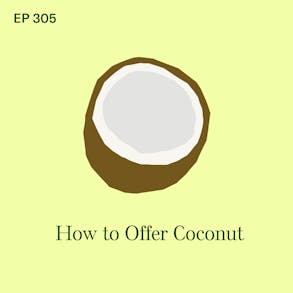
LISTEN TO THIS EPISODE
Episode Description
How do you make coconut safe for babies? Can they eat raw coconut…or flaked…and what about coconut milk? In this episode we’re breaking down a few easy ways to offer your baby coconut.
Links from this Episode
- Coconut rice pudding recipe
Coconut rice pudding is a very easy way to safely introduce coconut to your baby. It’s made with arborio rice (the same rice you use to make risotto), but you could substitute any short grain starchy rice. Rice is essentially hypoallergenic so it’s fine to introduce rice for the first time on the same day you try another low-risk non-allergenic food like coconut. Offer the porridge from a pre-loaded spoon or you can wait until it cools and form the porridge into logs about the size of your adult pinky finger and let baby self-feed.
INGREDIENTS
- 4 cups water
- 1 cup arborio rice
- 1 14-oz can unsweetened coconut milk
- ½ cup uns
- sweetened coconut threads or shredded coconut
- ½ teaspoon vanilla
INSTRUCTIONS
- In a large saucepan, combine the water and rice and bring to a boil. Simmer over medium heat, stirring frequently until the rice is tender and thick and creamy, about 30 minutes.
- Stir in the coconut milk and simmer, stirring occasionally until coconut milk has mostly evaporated, about 10 minutes.
- Crumble or pulse unsweetened coconut and add to the pudding. Add vanilla if using and stir to combine.
- Cool and offer pudding to the baby from a pre-loaded spoon. Alternatively, you can wait until pudding cools and thickens further, form into strips about the size of your adult pinky finger and offer to baby to self-feed.
- Want to get weekly BLW recipes by email? Click here to add your email address to my email newsletter: https://fortifiedfam.activehosted.com/f/9
- Baby-Led Weaning with Katie Ferraro program with the 100 First Foods™ Daily Meal Plan, join here: https://babyledweaning.co/program
- Baby-Led Weaning for Beginners free online workshop with 100 First Foods™ list to all attendees, register here: https://babyledweaning.co/baby-led-weaning-for-beginners

Latest Episodes

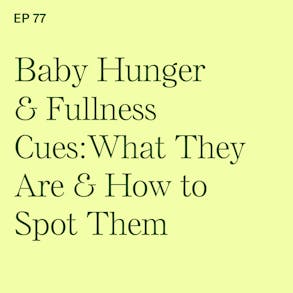
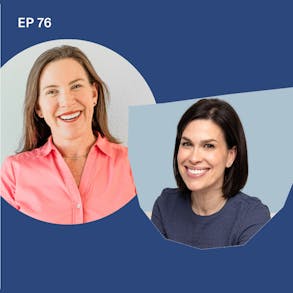
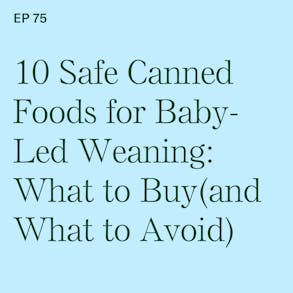
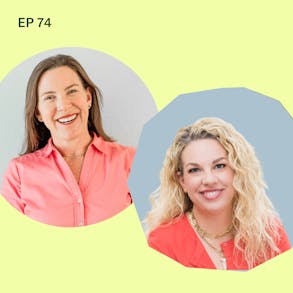
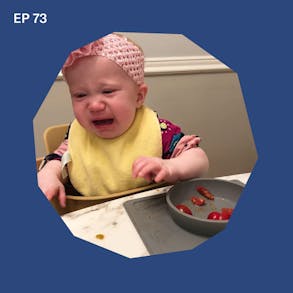
Katie Ferraro (30s):
And so whether you're trialing coconut cream or coconut milk, both for great for open cup practice is of course this is never in place of infant milk or breast milk. But coconut cream has a higher fat content. So coconut cream is four parts, coconut to one port water. It's got 19 to 22% fat. Much thicker consistency than coconut milk, which is still super high in fat, but fat is good for your baby still developing brain coconut milk has about nine to 15% fat and you can also practice drinking that out of the open cup in moderation. Hey there, I'm Katie Ferraro, registered dietitian, college nutrition professor and mom of seven specializing in baby-led weaning. Here on the Baby-led Weaning Made Easy podcast, I help you strip out all of the noise and nonsense about feeding, leaving you with the confidence and knowledge you need to give your baby a safe start to solid foods using baby-led weaning.
Katie Ferraro (1m 25s):
Well hey guys and welcome back. Today we're talking about coconut and how to safely feed coconut to your baby and the word coconut and the fruit coconut, sometimes confusing cuz people are like, is it a fruit, is it a seed, is it a nut? From a botanical standpoint, it technically can be all three. We're gonna be talking about coconut as it pertains to being a fruit. Coconut is on my 100 First Foods List of foods your baby can safely eat before they turn one. We're gonna be talking today about what is coconut? Why would you wanna feed coconut to your baby? We'll talk a little bit about the nutrition, the taste and the texture properties, and then some different forms and how we can offer coconut. The difference between coconut meat, coconut flakes, coconut milk. I know sometimes people get confused between coconut water and coconut milk.
Katie Ferraro (2m 8s):
I personally was interested in learning the difference between coconut milk and coconut cream and then stick around till the end because I'll be sharing one of my favorite recipes for baby-led weaning. It's a coconut rice pudding with no added sugar, a super easy way among others. That'll be sharing in this episode on how you can safely offer coconut to your baby. So as a fruit, a coconut is a food that you can safely offer to your baby. A couple of fun facts, a single coconut tree can harvest up to 180 coconuts in just one harvest. Now if you've ever tried to get into a coconut on your own, you know that it's definitely a fine art. I remember back when I was doing my second iteration of the 100 First Foods program with my baby twins, Gus and Hannah, when it was coconut day, I was like, you know, I'm gonna go to the store, I'm gonna give myself a coconut and try to get into it myself.
Katie Ferraro (2m 53s):
And it was kind of a disaster. I feel like I watched a lot of YouTube and still it was a disaster. It involved like safety goggles in me with a a hammer trying to poke the eyes out. It wasn't pretty. There's much easier ways to feed your baby coconut, but when it comes to the meat, like if you get into a coconut and you scrape out the meat yourself, it's hard and it's crunchy at which point it's not safe to offer your baby cuz we don't do any hard, crunchy or crispy foods, but thankfully there are safer ways to offer your baby coconut. Now why would you want to offer baby coconut from a nutrition standpoint? Okay, coconuts have B vitamins. They've got phosphorus, zinc, calcium, potassium, magnesium, iron. So they've got some vitamins and some minerals. And a unique thing about coconuts is that along with avocados, coconuts and avocados are the only two fruits that have fat and there's a lot of fat in coconut.
Katie Ferraro (3m 39s):
Whereas we talk about avocados are full of good fats, mostly unsaturated fats. Coconuts, on the other hand, are mostly lethal of saturated fats. So sometimes when you read things like don't feed babies coconuts cuz they're so full of saturated fat, you guys, the amount that babies are eating is so inconsequential that it really doesn't matter and a little bit of saturated fat is perfectly fine for your baby. Now do you want your baby eating like a hundred percent all super high saturated fat foods all day every day? No, but in moderation, like many of the foods we talk about on this podcast, it's perfectly safe for your baby to eat. Another cool thing about coconuts as it pertains to their fat, the fat content in coconuts is rich in laic acid, which is also one of the main fatty acids that's found in breast milk.
Katie Ferraro (4m 21s):
So coconut in no way replaces breast milk, but we do know that fats are important for your baby. Four, they're still developing brain. So we talk about lots of different high fat foods that babies can safely eat and coconut is one of them, although it's not like the only fat we want your baby to eat. So from a nutrition standpoint, there's benefits with vitamins, minerals, lots of fat. What about from a taste standpoint? How would you describe the taste of a coconut? Sometimes described as fruity, milky sweet with slight notes of like almost tastes like woody, like earthy. I know it's not as sweet as many other fruits. Sometimes people are like, that doesn't even qualify as a fruit to me. But I do like coconut for babies cuz it is a unique new flavor profile, right?
Katie Ferraro (5m 1s):
And we know that babies who are exposed to the greatest number of foods and flavors and tastes and textures early and often, those are the babies who become independent eaters. And that exposure, that diet diversity helps reduce the risk picky eating, which is part of the underlying principle of why we offer all of these foods to our babies during that flavor window when they'll readily like and accept this wide variety of foods and flavors and tastes and texture. So speaking of texture, the texture of coconut varies depending upon how we offer it, which we're gonna get to next. The meat of the coconut, if you eat it by itself, it can be kind of crunchy and crispy, but if you have it in a flaked form, it's soft and kind of pillowy. If you have coconut milk, it can be very thick.
Katie Ferraro (5m 42s):
Talk about the benefits of trying coconut milk out of an open cup because it's a thicker liquid like the type your baby's already used to, right? Breast milk or formula are thick liquids. You can taste a little bit of coconut milk out of the open cup as a way to try that different texture as well. Hey, we're gonna take a quick break, but I'll be right back.
Katie Ferraro (7m 8s):
So how do you offer coconut meat? We've talked about the coconut meat being like you have to poke the eyes of the coconut and you can drain the water and then you can scrape it out. Sometimes you can refrigerate it and make kind of removes the meats a little bit more easily. But if you, you know, don't have a lot of time to get your own coconut meat at the end of the day coconut meat on its own. Like big chunks of it. Two crispy, two crunchy four babies. So let's move on to coconut flakes with flaked coconut. I loved flake coconut for babies with one caveat, most of the flaked coconut that you're going to find is going to be sweetened, right? Like you would use it as in a baking application and already has sugar added to it. We don't want any added sugars for babies or children up until age two. So we need to look for unsweetened coconut flakes.
Katie Ferraro (7m 48s):
I know personally I find it at Trader Joe's, I have a Sprouts near me. They're called coconut threads at Sprouts, but it doesn't have added sugar. If the ingredient list only says coconut, that's what you're looking for, right? We don't want any added sugar. You generally don't find salted coconut flakes. So the sugar is what we're concerned about. Walmart has unsweetened coconut, it's about less than $3 a bag if you're in the Kroger family like Ralph's, they have unsweetened coconut Target also has an organic unsweetened coconut flake. So you might have to like search a little bit harder to find the unsweetened one, but it's definitely out there. So how can you safely offer coconut flakes? There's lots of ways you can mix it into already period foods. Like if your baby's already had yogurt, mix it in there. You can put it into oatmeal, you can sprinkle it on other foods that you're serving.
Katie Ferraro (8m 30s):
I like to make a coconut rice pudding. And again, I'm gonna share that recipe with you guys. It's in the description of this episode. It'll also be on the show notes at B L W podcast.com. So if you do the flakes or the threads, make sure they're unsweetened. Now what about coconut milk? I love coconut milk for babies. As I mentioned, that's a thicker liquid for babies to start drinking out of the open cup. I do wanna point out that we never replace coconut milk for infant milk. So coconut milk is not not a replacement for breast milk and or formula, right? This is just simply to practice tasting it or trying it or to try practice drinking out of an open cup. But it's not nutritionally equivalent. Nowhere even close to breast milk or formula. So not saying to substitute it, but sometimes you'll look online and you'll see things that say babies under one should not drink coconut milk.
Katie Ferraro (9m 13s):
I've tried to look into the sources of those recommendations. Oftentimes they're coming from like mommy bloggers and to be honest, people really not authorized to be teaching about infant feeding or nutrition. But from a safety standpoint, there's really no reason not to drink coconut milk. Just again mentioning we're not doing this in place of breast milk or formula. If you taste to practice that open cup drinking of course is perfectly fine. Now as far as coconut milk goes, I always used to buy light coconut milk like back in the day before I had kids when I was cooking for myself. Cause you're like looking at coconut milk, oh my gosh, there's so many calories. So super high in saturated fat. But then someone, my friend, she's a chef and she was like, why are you buying light coconut milk? It's just coconut milk with water added to it and you're paying the same price. And I started looking into it. And if you look at the ingredient list, like you know, they don't tell you exactly what the ratios are, but certainly light coconut milk is just coconut milk with water in it.
Katie Ferraro (9m 59s):
So if you wanna, you know, save some money, just buy your own coconut milk and then water down for yourself if you want for your babies. I'm not interested in watering anything down to cut back on saturated fat or calories, but just kind of a fun fact about coconut milk there. Now what about the difference between coconut milk and coconut cream? Okay, so coconut cream has a higher fat content. So cream is four parts, coconut and one part water. So it's got like 19 to 22% fat and it's a much thicker consistency, like it's pretty hard to drink. I just tried to drink some coconut cream ahead of this episode when I was preparing for you guys a little hard to stomach. I'll drink some coconut milk. Not like I love it, but like it's definitely something that I always take a taste of. If I'm offering it to the baby different cup, I'm not sharing the cups with other people's babies, guys, don't worry.
Katie Ferraro (10m 41s):
But coconut milk is a little bit lower fat content, nine to 15% fat, and then anything that's less than 9% fat content is considered to be light, okay? It has a thinner consistency and then a lower fat content compared to coconut cream. You do whatever works for you. Just read your labels and make sure that you don't see any added sugars in them. Now what about coconut water? Okay, so coconut water is a clear fat-free liquid that's made up of 94% water. Like remember, coconut water was like so super popular and trendy a while ago and so freaking expensive. Which kind of jokes on us because coconuts, if you actually like break it down, are not like one of the more expensive types of produce. But when it's highly processed and packaged and put in fancy bottles and tells you it has electrolytes, and by the way, mostly sodium, but the other, you know, there are some other minerals in there that do serve as electrolytes in coconut water, but there's nothing magical about coconut water, which I feel like for a while there, food manufacturers and marketers want us think there was.
Katie Ferraro (11m 35s):
But the coconut water, because it doesn't have the fat, okay, it's not, it's just the, the watery part in the inside of the coconut. It doesn't even come close to containing, you know, all of the nutrition that you would get from coconut meat and coconut milk because of course that's where all the fat is. So coconut water, it's low in calories, low in sugar, it's fat and cluster all free. So it's kind of like, you know, trendy adult diet food. If you like coconut water, more power to you, but not necessarily something that we're gonna be offering to babies. Okay? Our babies don't need coconut water. Hey, we're gonna take a quick break, but I'll be right back.
Katie Ferraro (13m 12s):
Now, can you be allergic to coconut? Okay. Allergy to coconut is almost unheard of, even though it has the word nut in its name. Coconuts are not nuts. They are not a type of tree nut that's classified from the allergenic standpoint. So you don't need to worry about your baby being allergic to coconut, but coconut also doesn't count if you're trying to knock off tree nut from the list of the big nine allergenic foods that you're going to feed your baby. One of my favorite ways to incorporate both coconut milk and unsweetened coconut flakes is to make the coconut rice pudding recipe that I was mentioning. I've made this for babies in the first week of baby lead weenie.
Katie Ferraro (13m 53s):
A lot of times they absolutely love it. Now, we normally don't advocate for the use of a lot of rice foods anymore, right, because of the potential for arsenic toxicity. But rice is a staple food in many different food cultures around the world. If your family eats rice and you wanna find a way to incorporate that for your baby, I say go for it. Just keep it in moderation. So the coconut rice pudding recipe has both coconut milk and unsweetened coconut in it. I'm gonna link that it'll be right in the description where you're listening to this podcast or on the show notesPage@bwpodcast.com slash 3 0 5. And if you're interested in learning more about reducing arsenic in the rice foods that you're preparing for your baby, go back and listen to episode 144.
Katie Ferraro (14m 33s):
It's about implementing the pasta water cooking method for making rice lower in arsenic. I walk you through how to do that. I would suggest doing that to the rice first before you incorporate it into the coconut rice pudding recipe. Another good episode is episode 157. I interviewed Charlotte Roadie and Jane Houlahan. They're from Healthy Babies, bright Futures. They've done some very important work in the space of publishing about heavy metals in baby foods. And we talked a lot about arsenic in baby food. That was back in episode 157, and if you just can't get like enough heavy metals in baby food content, I also had the head scientist from Consumer Reports, Dr. Jamesy Rogers on in episode 208, and we talked to kind of zoomed out and looked at the bigger picture of heavy metals and baby food.
Katie Ferraro (15m 14s):
That episode had a lot of focus on Mercury with regards to mercury in tuna. Consumer reports has done a lot of work there. But we also chatted a little bit about arsenic and rice foods too. So I don't wanna scare you off of rice foods cuz if you want to eat them in moderation, it's totally fine. I think the coconut dot rice pudding is a great way to introduce your baby to both coconut, which they're not gonna be allergic to, and rice, which they're not going to be allergic to. And then you can check coconut off the hundred first foods list from the fruit category. If you want to grab a copy of my hundred first foods list, I give it away to everybody on my free one hour-ish online video workshop training called Baby-Led Weaning for Beginners. We just redid that workshop recently with a little bit of a longer q and a portion, so I make a point to answer everybody's questions on that workshop.
Katie Ferraro (15m 56s):
You can sign up for this week's workshop times and grab your copy of the hundred first Foods list all for free at https://babyledweaning.co. Again, that's https://babyledweaning.co, or click the link in this podcast episode description and if you make that sugar free coconut rice pudding recipe for your baby, let me know how it turns out. Thanks so much for listening. I'll see you guys next time.

The Program Baby-Led Weaning with Katie Ferraro
A step-by-step digital program for starting solid foods safely and navigating the original 100 FIRST FOODS™ meal plan with baby-led weaning.
 EXPERT-LED, PROVEN APPROACH TO EATING REAL FOOD
EXPERT-LED, PROVEN APPROACH TO EATING REAL FOOD CONCISE VIDEO TRAININGS TO MASTER BABY-LED WEANING
CONCISE VIDEO TRAININGS TO MASTER BABY-LED WEANING 100 FIRST FOODS DAILY MEAL PLAN WITH FOOD PREP VIDEOS
100 FIRST FOODS DAILY MEAL PLAN WITH FOOD PREP VIDEOS
Baby-Led Weaning for Beginners Free Workshop
Is your baby ready to start solid foods, but you’re not sure where to start? Get ready to give your baby a solid foundation to a lifetime of loving real food…even if you’re feeling overwhelmed or confused about this next stage of infant feeding.
Get baby-led weaning recipes and tips delivered to your email inbox.

